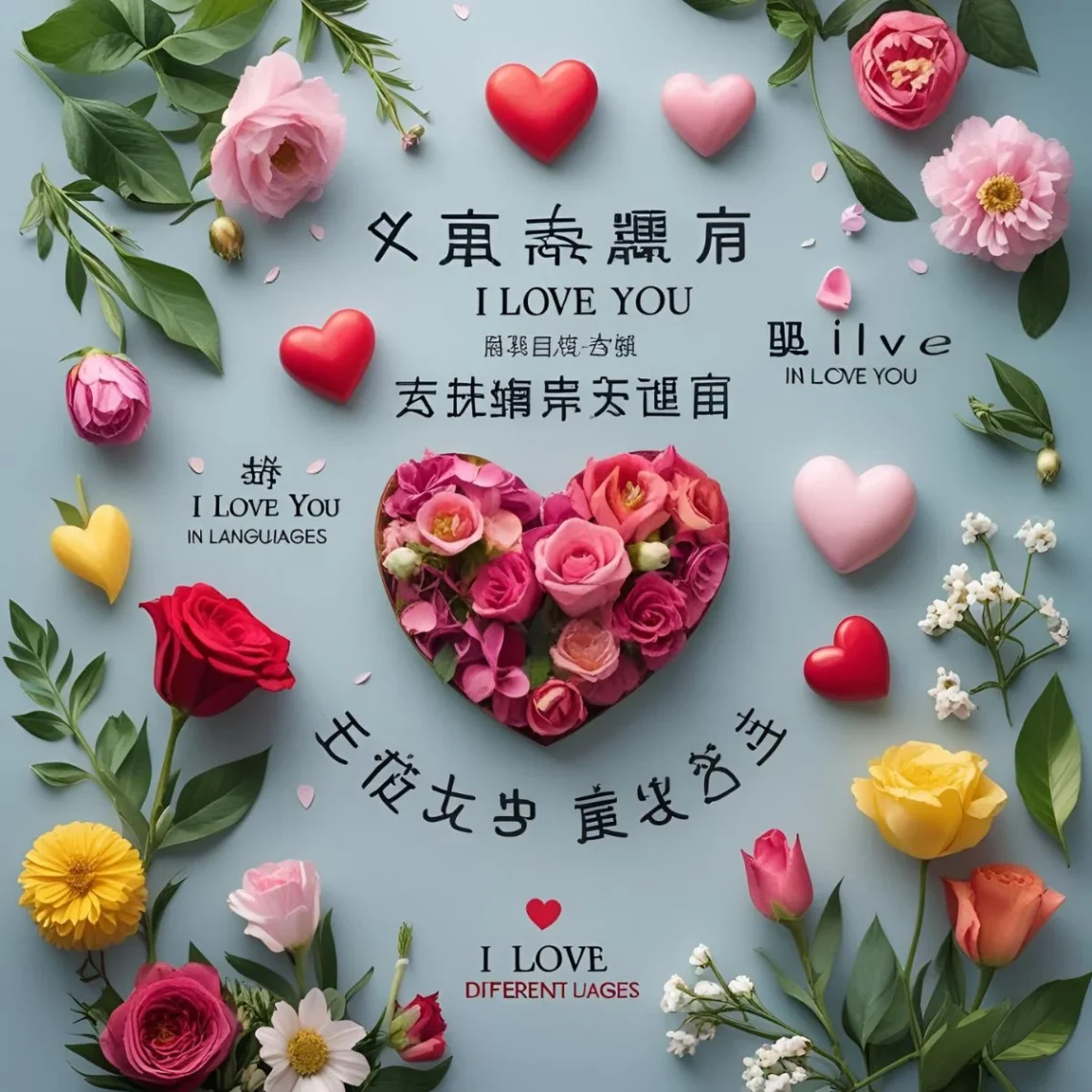Love’s Universal Script 🌍
In a quiet Kyoto temple, “Aishiteru” is penned on delicate rice paper, sealing a vow 🖌️. Meanwhile, in a bustling Accra market, “Mo nifẹ rẹ” is scrawled on a note, sparking joy 📝. Globally, writing “I love you” captures hearts across cultures. For instance, from Paris’ love letters to Maori carvings, these words unite us. Moreover, each script adds unique beauty, reflecting local soul. Thus, let’s explore how “I love you” is written worldwide, celebrating its heartfelt diversity! 💞
Reference Table: “I Love You” Across Languages 📊
To clarify how “I love you” is written globally, the table below lists the phrase in 15 languages with cultural insights.
| Language | Phrase for “I Love You” | Cultural/Linguistic Insight |
|---|---|---|
| French | Je t’aime | Penned in elegant cursive for Parisian love letters 🇫🇷. |
| Spanish | Te amo | Written in passionate notes, common in Spain’s serenades 🇪🇸. |
| German | Ich liebe dich | Inked in precise script, used for deep German commitments 🇩🇪. |
| Italian | Ti amo | Scrawled in romantic Italian postcards, tied to family bonds 🇮🇹. |
| Mandarin | Wǒ ài nǐ (我爱你) | Brushed in Chinese calligraphy, often subtle in China 🇨🇳. |
| Hindi | Main tumse pyar karta hoon | Written in Devanagari, fuels India’s Bollywood love stories 🇮🇳. |
| Japanese | Aishiteru (愛してる) | Penned in kanji, reserved for profound moments in Japan 🇯🇵. |
| Korean | Saranghae (사랑해) | Scribbled in hangul, popular in South Korea’s K-drama notes 🇰🇷. |
| Arabic | Uḥibbuk (أحبك) | Calligraphed in Arabic script, poetic in Middle Eastern traditions 🇪🇬. |
| Swahili | Nakupenda | Written in communal letters, warm in East African bonds 🌍. |
| Zulu | Ngiyakuthanda | Inked in heartfelt South African proposals 🇿🇦. |
| Yoruba | Mo nifẹ rẹ | Scrawled in Nigerian love notes, vibrant in festivals 🇳🇬. |
| Maori | Aroha atu au ki a koe | Carved in New Zealand’s communal art, reflects love for land 🪶. |
| Hawaiian | Aloha au iā ‘oe | Written in tropical notes, tied to Hawaii’s aloha spirit 🌺. |
| Cherokee | Gvgeyuhi | Etched in syllabary, symbolizes enduring Native American bonds 🦅. |
European Languages: Romantic Inscriptions 🎶
Firstly, in Europe, “I love you” is written with passion. For example, France’s “Je t’aime” graces cursive love letters in Paris 🇫🇷. Similarly, Spain’s “Te amo” is penned in fiery notes, used in Seville’s serenades 🇪🇸. Meanwhile, Germany’s “Ich liebe dich” is inked precisely, reflecting serious Berlin vows 🇩🇪. Additionally, Italy’s “Ti amo” adorns romantic postcards in Rome 🇮🇹. Furthermore, Russia’s “Ya tebya lyublyu” is written in Cyrillic, heartfelt in Moscow 🇷🇺.
Moreover, the phrase spans Portugal (“Eu te amo”), Netherlands (“Ik hou van je”), Sweden (“Jag älskar dig”), Poland (“Kocham cię”), Greece (“S’agapó”), Romania (“Te iubesc”), Hungary (“Szeretlek”), Finland (“Rakastan sinua”), Norway (“Jeg elsker deg”), Denmark (“Jeg elsker dig”), Belgium (“Ik hou van je/Je t’aime”), Austria (“Ich liebe dich”), Switzerland (“Ich liebe dich/Je t’aime”), Czech Republic (“Miluji tě”), Slovakia (“Ľúbim ťa”), Croatia (“Volim te”), Serbia (“Volim te”), Ireland (“Tá grá agam duit”), Ukraine (“Ya tebe kohayu”), and Bosnia (“Volim te”). Thus, each script unites Europe in love’s embrace.
Asian Languages: Soulful Calligraphy 🏮
Next, Asia writes “I love you” with nuance across 20+ countries. For instance, China’s Mandarin “Wǒ ài nǐ” (我爱你) is brushed in Beijing calligraphy, often subtle 🇨🇳. Likewise, Hindi’s “Main tumse pyar karta hoon” in India, Fiji, and Nepal is in Devanagari, fueling Mumbai’s love tales 🇮🇳. Meanwhile, Japanese “Aishiteru” (愛してる) in Japan is penned in kanji, rare and deep in Kyoto 🇯🇵. Similarly, Korean “Saranghae” (사랑해) in South Korea and North Korea is in hangul, scrawled in Seoul 🇰🇷.
Furthermore, Arabic’s “Uḥibbuk” (أحبك) spans Egypt, Saudi Arabia, Morocco, Algeria, Iraq, Syria, Jordan, Lebanon, UAE, Qatar, Kuwait, Oman, Yemen, Bahrain, Libya, Tunisia, Sudan, Palestine, Mauritania, Somalia, Djibouti, and Comoros, calligraphed poetically in Cairo 🇪🇬. Additionally, Thai (“Phǒm rák khun” in Thailand), Vietnamese (“Anh yêu em” in Vietnam), Malay (“Saya sayang awak” in Malaysia), Tagalog (“Mahal kita” in Philippines), and Tamil (“Nān unnai kātalikkirēn” in Sri Lanka) add warmth. Thus, Asia’s scripts weave love’s diversity.
African Languages: Vibrant Expressions 🌍
Additionally, Africa’s “I love you” is written with soul across 20+ countries. For example, Swahili’s “Nakupenda” in Kenya, Tanzania, Uganda, Rwanda, Burundi, DR Congo, Mozambique, and Malawi graces communal letters in Nairobi 🌴. Similarly, Zulu’s “Ngiyakuthanda” in South Africa is inked in Durban’s proposals 🇿🇦. Meanwhile, Yoruba’s “Mo nifẹ rẹ” in Nigeria and Benin is scrawled in Lagos’ festive notes 🇳🇬.
Moreover, Amharic’s “Əfäḳräḥ” in Ethiopia is written in Addis Ababa’s family letters. Likewise, Hausa’s “Ina son ki” in Nigeria and Niger suits northern vows. Furthermore, Shona (“Ndinokuda” in Zimbabwe), Xhosa (“Ndiyakuthanda” in South Africa), Tswana (“Ke a go rata” in Botswana), Oromo (“Sin jaalladha” in Ethiopia), Somali (“Waan ku jeclahay” in Somalia), Tigrinya (“Yifqireka” in Eritrea), Wolof (“Dama la bëgg” in Senegal), Fula (“Mi yidi ma” in Guinea), Akan (“Medɔ wo” in Ghana), Luganda (“Nkwagala” in Uganda), Kinyarwanda (“Ndakukunda” in Rwanda), Malagasy (“Tiako ianao” in Madagascar), Bemba (“Nalikutemwa” in Zambia), Lingala (“Nalingi yo” in DR Congo), Twi (“Medɔ wo” in Ghana), Chewa (“Ndimakukonda” in Malawi), and Sotho (“Kea u rata” in Lesotho) bind communities. Thus, Africa’s scripts pulse with love.
Indigenous & Island Languages: Sacred Writings 🌺
Furthermore, indigenous and island languages write “I love you” with depth across 20+ regions. For instance, Maori’s “Aroha atu au ki a koe” in New Zealand is carved in Rotorua’s art, loving land and people 🪶. Similarly, Hawaiian’s “Aloha au iā ‘oe” in Hawaii (USA) is written in tropical notes on Oahu 🌴. Meanwhile, Cherokee’s “Gvgeyuhi” in United States communities, like Oklahoma, is in syllabary, enduring bonds 🦅.
Additionally, Samoan’s “Ou te alofa ia te oe” in Samoa and American Samoa strengthens villages. Likewise, Guarani’s “Rohayhu” in Paraguay, Quechua’s “Kuyayki” in Peru, Bolivia, and Ecuador, Inuktitut’s “Asavakkit” in Canada, Yolngu’s “Ŋarra nhäŋu ŋunhi ŋarraku yothu” in Australia, Tongan’s “‘Ofa atu” in Tonga, Fijian’s “Au domoni iko” in Fiji, Chamorro’s “Hu guaiya hao” in Guam, Tahitian’s “Ua here vau ia oe” in French Polynesia, Marshallese’s “Iakwe yuk” in Marshall Islands, Palauan’s “Ak morolung er kau” in Palau, Nauruan’s “Eko ngan amo” in Nauru, Niuean’s “Fakaalofa atu kia koe” in Niue, Cook Islands Maori’s “Aro’a atu au kia koe” in Cook Islands, Yapese’s “Gadaaw u waab” in Micronesia, Kosraean’s “Ngoh muhk fohk sruhk” in Micronesia, Pohnpeian’s “I iang kowe” in Micronesia, Chuukese’s “Ami meefi au” in Micronesia, and Iban’s “Aku sayau ke nuan” in Malaysia root love in tradition. Thus, these scripts sing of devotion.
Cultural Insights: Love’s Written Legacy 🕰️
Initially, writing “I love you” captures timeless devotion. For example, Latin “Ego te amo” seeded Romance scripts, tied to Roman poetry 📜. Meanwhile, in Chinese, “Wǒ ài nǐ” (我爱你) emerged with Western romanticism, brushed in Beijing 🇨🇳. Additionally, Swahili’s “Nakupenda” reflects Bantu bonds, written in East Africa’s letters 🌍.
Furthermore, in Arabic, “Uḥibbuk” (أحبك) echoes Rumi’s calligraphy, blending spiritual love 🕌. Similarly, Cherokee’s “Gvgeyuhi” in syllabary grounds oral traditions 🦅. Moreover, colonialism spread scripts—Quechua’s “Kuyayki” gained Christian hues, while Maori’s “Aroha” preserved depth. Today, from K-drama’s “Saranghae” to Bollywood’s “Main tumse pyar karta hoon,” written love unites humanity’s heart.
Sayings About Love’s Expression 🗣️
The table below organizes 12 sayings about “I love you,” emphasizing devotion and connection.
| Culture/Language | Saying | Meaning | Country |
|---|---|---|---|
| Spanish | Te amo es el latido de mi alma. | I love you is my soul’s heartbeat, emphasizing passion. | Spain 🇪🇸 |
| Japanese | Aishiteru wa inochi no kagayaki. | I love you is life’s glow, reflecting sincerity. | Japan 🇯🇵 |
| Yoruba | Mo nifẹ rẹ bi òkun ti ń ru. | I love you like the roaring ocean, symbolizing depth. | Nigeria 🇳🇬 |
| Maori | Aroha he wairua kotahi. | Love is one spirit, focusing on unity. | New Zealand 🪶 |
| Arabic | Uḥibbuk nūran fi qalbī. | I love you is light in my heart, tied to poetry. | Egypt 🇪🇬 |
| Swahili | Nakupenda kama nyota angani. | I love you like stars in the sky, emphasizing beauty. | Kenya 🌍 |
| Hawaiian | Aloha au iā ‘oe me he kumu lā. | I love you like a tree, tied to aloha’s roots. | Hawaii 🌺 |
| Zulu | Ngiyakuthanda njengempilo yami. | I love you like my life, focusing on vitality. | South Africa 🇿🇦 |
| Cherokee | Gvgeyuhi is the earth’s embrace. | I love you binds us to nature, tied to heritage. | USA 🦅 |
| Hindi | Main tumse pyar karta hoon jaise suraj chamakta hai. | I love you like the sun shines, symbolizing warmth. | India 🇮🇳 |
| Amharic | Əfäḳräḥ kämä qädmäñña näfs. | I love you like an ancient soul, emphasizing eternity. | Ethiopia 🇪🇹 |
| Guarani | Rohayhu ha’e ñande yvyrá. | I love you is our tree, reflecting bonds. | Paraguay 🇵🇾 |
FAQs ❓
The table below answers six key questions about “I love you” for clarity.
| Question | Answer |
|---|---|
| Why do some scripts for “I love you” look similar? | Latin “amo” seeded “Te amo” and “Ti amo”; short forms like “Saranghae” are efficient. |
| What’s the oldest written “I love you”? | Sumerian poetry (2000 BCE) and Sanskrit “Priyāmi” (1500 BCE) express written devotion. |
| How do cultures write “I love you”? | Japan’s “Aishiteru” is rare, in kanji 🇯🇵; Nigeria’s “Mo nifẹ rẹ” is vibrant 🇳🇬; Hawaii’s “Aloha au iā ‘oe” is tropical 🌺. |
| How did colonialism affect written “I love you”? | Missionaries added Christian romance to Quechua’s “Kuyayki”; Maori’s “Aroha” kept depth 🪶. |
| How does gender influence written “I love you”? | Hindi’s “karta hoon” (male) vs. “karti hoon” (female) shows grammar; Yoruba’s “Mo nifẹ rẹ” is neutral. |
| Why is “I love you” less written in some cultures? | In Japan and China, love is shown via actions, with “Aishiteru” or “Wǒ ài nǐ” rarely written. |
Conclusion: Love’s Global Script 🌏
Ultimately, from “Je t’aime” in French letters to “Aroha atu au ki a koe” in Maori carvings, writing “I love you” binds hearts worldwide. Indeed, each culture adds its stroke—passion in Spain, restraint in Japan, warmth in Swahili—yet all share love’s power. 💕 For example, picture this with a map of love’s scripts or audio of these phrases! Now, share your story: How is “I love you” written in your language? Perhaps tell us about a love note or a moment it touched you. Drop it in the comments and let’s celebrate love’s global script! 💬





